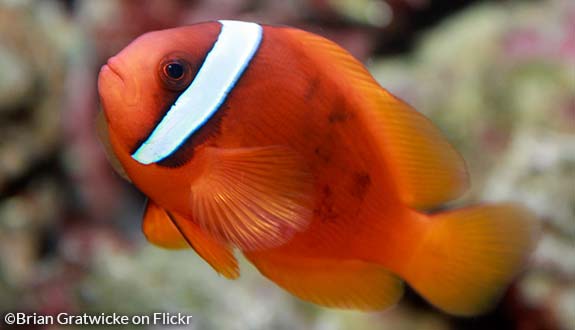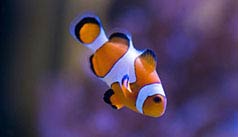

Alternative species (click on the thumbnail to see the card)
Names
Scientific name
Amphiprion frenatus
Amphiprion polylepis
Prochilus polylepis
Common name
Tomato clownfish
Blackback anemonefish
Bridled anemonefish
Fire clown
Red tomato clown
Origin

Origin: Pacific and Indian Ocean (Africa)
Natural habitat: Found in coral reefs where it lives in symbiosis with anemones of the genera Heteractis, Stoichactidae or Entacmaea quadricolor
Dimorphism
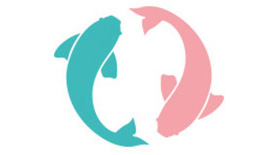
That's easy. The female is significantly larger and taller than the male.
Group
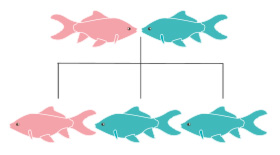
Pomacentridae
Volume

200 L / 44 Imp Gal / 53 US Gal
Parameters

T°: 23 to 26°C or 73 to 79°F
pH: 7.8 to 8.5
Density: 1021 to 1025
Difficulty

Easy
Size

Male: 10cm (4") / Female: 12cm (4.8")
Longevity

5 to 10 years
Living zone
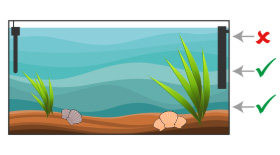
Middle and depth
Individuals
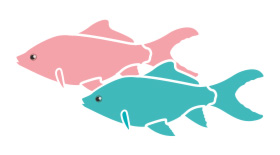
Couple
Food
How to feed the Tomato clownfish?
Food
How to feed the Tomato clownfish?
Feeding this species is relatively easy. For a nice shape, offer live or frozen prey (tubifex, cyclops, artemia, daphnia...). A regular algae supplement is also beneficial.
Pellets and dry food are accepted, but only as a supplement (for the aquarist's convenience).
Behavior
What kind of behavior does the Tomato clownfish have?
Behavior
What kind of behavior does the Tomato clownfish have?
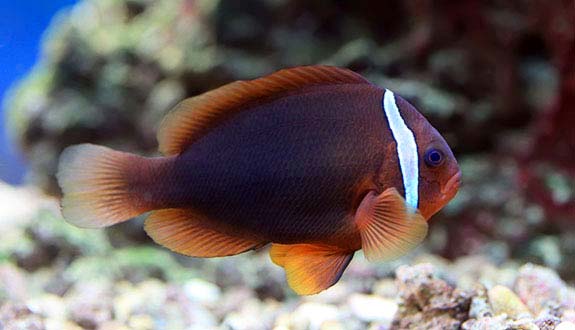
This species is territorial: the dominant couple will defend their anemone against their fellow anemones. They will be quite aggressive on this occasion (but still much less than their cousins Ocellaris or Polymnus). For this reason, install only one clownfish pair per aquarium.
Tomato clownfish are lively and active all the time. However, they do not leave their territory and will always stay close to their anemone.
Cohabitation
Who can live with the Tomato clownfish?
Cohabitation
Who can live with the Tomato clownfish?
It is difficult for them to cohabit with their peers (see "behaviour"). Also avoid associating it with other clownfish species as it would show the same aggressive behaviour towards them.
In a sufficiently large aquarium, the red clownfish is peaceful with all other species of fish.
A clownfish is an anemone. In the case of Amphiprion frenatus, the association with anemones such as Heteractis, Stoichactidae or Entacmaea quadricolor is one of the most appropriate since it is perfectly natural.

Breeding
How to breed the Tomato clownfish?
Breeding
How to breed the Tomato clownfish?
It is quite easy to obtain spawning when maintenance conditions are good. Fry are more difficult to raise, partly because of their feeding.
The fish reach sexual maturity at the age of one year. Encourage spawning by distributing live prey. When the couple is getting ready to spawn, they will start cleaning a stone near their anemone. Laying takes place at night. During the night, the female deposits eggs that the male will then fertilize. Incubation lasts between 8 and 10 days.
The fry must be isolated for efficient rearing. To do this, take the rock on which the brood is installed and place it in the rearing aquarium. Take care that the eggs do not come into contact with the air. The host aquarium will be about 50 litres / 11 Imp Gal / 13 US Gal, filled with the same water as the laying tank and can be bare, without decoration. The ideal time to collect the brood is when you can see the eyes of the fry through the eggs, and they turn a silvery colour. Hatching will take place about 24 hours later.
The juveniles have two white lines: one wide behind the eye and the other thinner in the middle of the body. This last line will disappear during their growth (when they exceed 4 cm) and only the widest line will remain. Pay attention to the cleanliness of the rearing tank because the fry are very sensitive to water pollution.
Feeding the fry: enriched rotifers and SERA MICRON powder then after 5 days nauplias of artemia. The meals will be distributed at least 3 times a day. The first 7 days are critical and losses will occur. After that, the chances of survival are improved.
Interestingly, this is a species with protandric hermaphroditism. Behind this complicated word hides a curiosity: all the fry are male! They all have the capacity to become females, but only the dominant and biggest ones will succeed. In the wild, the social group is hierarchical around a single female, who can perfectly well own a male harem. She usually associates with the largest male in the group to form the dominant pair. If one day this female would die, the dominant male would then transform into a female, and the second largest male would then take the place of the male who has metamorphosed. For you, this means that if you buy 2 clownfish, you will necessarily have a couple.
Its aquarium
Which aquarium for the Tomato clownfish?
Its aquarium
Which aquarium for the Tomato clownfish?
A reef aquarium is perfect for the maintenance of this species. It will be composed of live rocks and corals.
These fish form with their anemones a symbiosis, i.e. a lasting and mutually beneficial biological association between two living organisms.
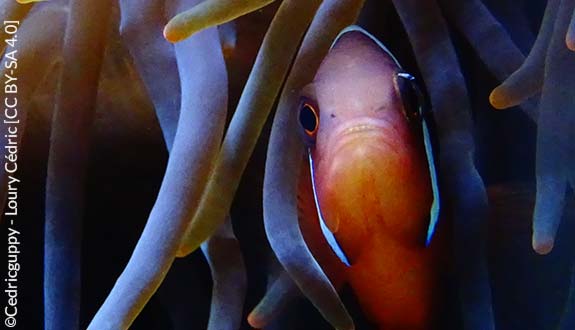
The anemone provides a safe refuge for clownfish from predators in its habitat from stinging tentacles, and in turn feeds, cleans and protects the anemone from its own predators. Ideally, offer your clown-fish a large anemone such as Heteractis, Stoichactidae or Entacmaea quadricolor, it is essential for their well-being! If you don't have any, they can make do with a colony of Rhodactis or an Euphyllia.
The presence of numerous hiding places is very beneficial to the species.
Keep the nitrate level rather low (below 50 mg/l) because clownfish are quite sensitive to it. Regular water changes are therefore imperative.
Good To know
Find all additional information!
Good To know
Find all additional information!
Red clownfish (or "tomato") have colours that are quite similar to each other (for example, Amphiprion melanopus is very similar to Amphiprion frenatus). Thus, when they are young, there can be a lot of confusion. For example, confusion with Amphiprion Ephippium may be possible. Note that Amphiprion Frenatus has a wide post-ocular white band (usually bordered with black) and a very thin band in the middle of the body when they are young that disappears in adulthood).
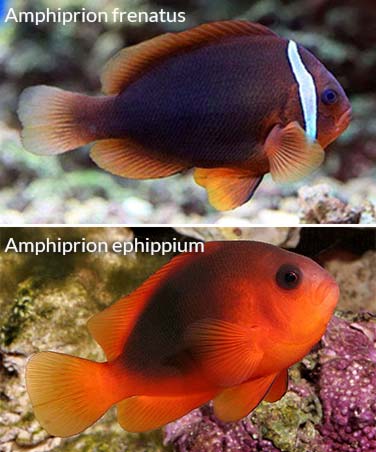
Its coloration varies greatly depending on its age and on the individuals: generally young fish are bright orange, while older fish easily turn brown.
Very robust, the acclimatization of this fish is not a problem. In fact, it is one of the strongest Amphiprion. It is therefore perfectly adapted for beginners in marine aquarium keeping. It should nevertheless be noted that it is slightly susceptible to white spot disease like all marine fish.
Its name "frenatus" means "with a bridle". Looking at his physique, no need to tell you what it refers to!
Clownfish can live among the stinging tentacles of the anemone because they coat themselves with the mucus that the anemone produces to prevent their tentacles from burning each other.
Yours photos!
Comments
Sort by:
Please login to post comments
